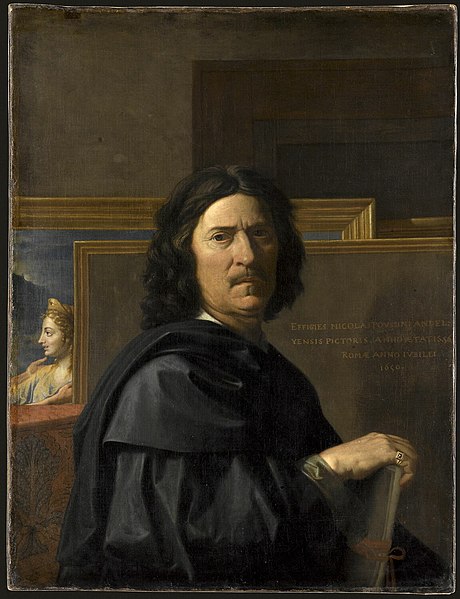
Born: June 1594, Normandy
Died: 19 November 1665 (aged 71)
Period: Classicism, Baroque
The Life of Nicolas Poussin
Nicolas Poussin was a French painter who became a central figure in the classical art movement of the 17th century. His work is characterized by its clarity, logic, and order, and it played a key role in shaping the French art scene of his time. Poussin’s art is known for its disciplined approach to composition and its profound engagement with themes from antiquity and mythology, setting standards that would influence generations of artists.
Early Life and Education Born in the Normandy region of France, Poussin’s early education in the arts was relatively modest. He began his artistic training in his native France but found the artistic environment there unsatisfactory for his ambitions. Seeking a deeper connection to the classical traditions, Poussin moved to Rome in 1624, which was then the center of the artistic world. This decision marked the beginning of a lifelong attachment to the city and its ancient history.
Career in Rome In Rome, Poussin immersed himself in the study of classical antiquity and the works of Renaissance masters. He became a leading proponent of the classical style, focusing on historical and mythological subjects rendered with precision and a profound moral and philosophical depth. His paintings from this period, such as “The Death of Germanicus” (1627) and “The Rape of the Sabine Women” (1637-1638), showcase his skill in composition and his ability to convey complex narratives through art.
Poussin’s work attracted the attention of patrons and scholars, and he developed a close circle of intellectual friends. Despite his success, he led a mostly secluded life, dedicated to his studies and his art.
Return to France and Later Years In 1640, Poussin was summoned back to France by King Louis XIII and appointed First Painter to the King. However, his time in France was short-lived and not particularly happy; he found the court life stifling and was disillusioned by the interference of patrons in his work. In 1642, he returned to Rome, where he would spend the rest of his life.
Poussin’s later works continued to explore classical themes, but with a greater emphasis on landscape, integrating his figures into harmonious natural settings. This period includes works like “Landscape with Orpheus and Eurydice” (1650-1651) and “The Four Seasons” series (1660-1664), which are celebrated for their poetic and philosophical depth.
Legacy Nicolas Poussin died on November 19, 1665, in Rome. His legacy is that of a master who elevated painting to intellectual heights, emphasizing the importance of drawing, composition, and thematic rigor. His approach to art as a vehicle for expressing the noblest human ideals had a profound impact on the development of French classical painting and the neoclassical movement that would emerge centuries later. Poussin is remembered not just as a painter but as a thinker who articulated a vision for art that was deeply rooted in the intellect and the traditions of the past.
Nicolas Poussin’s Notable Works
Nicolas Poussin is revered for his contribution to classical art, deeply influenced by the ideals of antiquity and the Renaissance. His works are celebrated for their disciplined composition, clarity of form, and intellectual depth. Here are ten of his most famous works, which encapsulate the essence of his artistic vision:
- “The Death of Germanicus” (1627) – This painting captures the dramatic moment of Germanicus’s death, showcasing Poussin’s ability to convey intense emotion and narrative depth within a rigorously composed setting.
- “Et in Arcadia Ego” (also known as “The Arcadian Shepherds”, c. 1637-1638) – A meditation on mortality, depicted through shepherds discovering a tomb in Arcadia, symbolizing the presence of death even in utopian realms.
- “The Rape of the Sabine Women” (1637-1638) – This dynamic composition illustrates the legendary episode from Rome’s early history, emphasizing the chaos and emotion of the moment.
- “Landscape with Orpheus and Eurydice” (1650-1651) – A work that beautifully integrates human figures into a serene and harmonious landscape, telling the tragic story of Orpheus and Eurydice.
- “The Seven Sacraments” series (1640s) – A set of paintings depicting the seven sacraments of the Catholic Church, notable for their spiritual depth and the integration of biblical scenes with classical settings.
- “The Four Seasons” series (1660-1664) – Representing spring, summer, autumn, and winter through scenes from the Bible and classical mythology, these paintings are among Poussin’s last works, reflecting his enduring interest in the cycles of nature and human life.
- “The Adoration of the Golden Calf” (1633-1634) – Poussin explores themes of idolatry and divine retribution in this depiction of the Israelites worshipping the golden calf, highlighting his mastery of complex compositions.
- “The Crossing of the Red Sea” (1633-1634) – Another biblical scene, this painting is celebrated for its dramatic depiction of Moses parting the Red Sea, demonstrating Poussin’s skill in portraying motion and emotion.
- “The Kingdom of Flora” (c. 1631) – This painting depicts various mythological figures associated with flora, showcasing Poussin’s ability to weave together multiple stories into a cohesive and visually stunning tableau.
- “The Holy Family on the Steps” (1648) – A serene and intimate depiction of the Virgin Mary, Joseph, and the Christ child, balanced with classical architecture, reflecting Poussin’s interest in harmonizing sacred subjects with his classical sensibilities.
Poussin’s work has had a lasting impact on the development of Western art, influencing generations of artists with his commitment to classical ideals, disciplined composition, and intellectual engagement with his subjects.